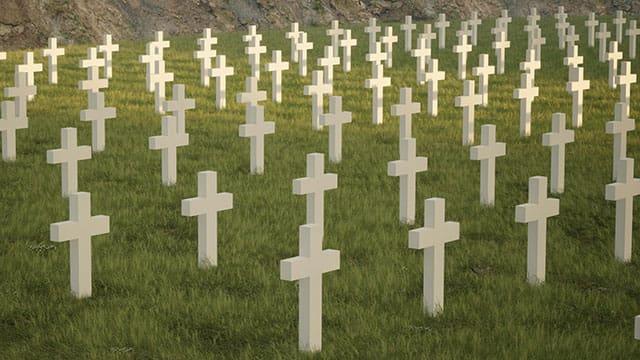Remembrance Day: Each grave tells a story of courage and the values that define Canada

For interview requests, click here
There is a grave on a riverbank near Batoche, Saskatchewan. It contains the remains of a soldier from Ontario who died in 1885 under General Middleton during the last battle of the Northwest Rebellion. It has been tended for almost 150 years by the Métis families whose ancestors had fought against him. His name was Gunner William Phillips, and he was 19 years old.
Up a dirt road in the Boshof District of Free State, South Africa, is a memorial garden in which are buried the 34 bodies of Canadians killed at the Battle of Paardeberg in 1900. They fell while driving a Boer kommando off the heights where they had been dug in and inflicting severe casualties on the British forces below. Private Zachary Richard Edmond Lewis of the Royal Canadian Regiment lies there. He was the son of Millicent Lewis and was 27 years old.
On Apr. 22, 1915, the German army launched its first poison gas attack on Allied trenches near Ypres, Belgium, during the First World War. When French troops on their flanks broke and ran, the 1st Canadian Division stood fast amid the chlorine cloud and repelled their attackers, suffering 2,000 casualties in the process. On the grave of Private Arthur Ernest Williams of the 8th Battalion are the words, “Remember, He Who Yields His Life is a Soldier and a Man.” Private Williams was 16 years old.
When the Japanese invaded Hong Kong in December 1941, Canadian troops from the Winnipeg Grenadiers were there to resist them. Among them was Sergeant-Major J.R. Osborn, whose men were surrounded and subject to grenade attacks. Osborn caught several of these and flung them back, but when one could not be retrieved in time, he threw himself on the grenade as it exploded in an attempt to save his men. His body was never found after the battle but his name is inscribed on a monument in Sai Wan Bay War Cemetery.
In the hills south of Algiers is Dely Ibrahim Cemetery, where they buried the body of RCAF Pilot Officer John Michael Quinlan after the crash of his Wellington bomber in March 1944. He was a movie-star handsome student from Prince Albert, Saskatchewan and my father’s best friend in the squadron. I carry his family name as my middle name as does my little grand-daughter.
The Kandahar Cenotaph in the Afghanistan Memorial Hall at National Defence Headquarters in Ottawa honours those Canadians who died fighting Islamic terrorists. One hundred fifty-eight stones are bearing the faces of the soldiers who were repatriated from where they fell and now are buried in graves in their home communities across the country. One of those stones commemorates Warrant Officer Gaétan Joseph Francis Maxime Roberge of the Royal 22nd Regiment, who is buried in a cemetery in Sudbury. He was 45 when he was killed by a bomb. He left behind a wife, an 11-year-old daughter and twin six-year-old girls.
On Nov. 11, we pause to remember the 118,000 Canadian men and women who died fighting, among others, Fenian invaders, Islamic jihadis in Sudan, the armies of Kaiser Wilhelm, Benito Mussolini, and Imperial Japan, Nazi SS Panzer regiments, Chinese and North Korean forces, ethnic warlords in the Balkans, and the Taliban. They died in North Atlantic convoys, in French trenches, in primitive field hospitals, on beaches in Normandy, in the air over England, on frozen hills in Korea, in jungle POW camps, on peace-keeping duty in Cyprus, in the Medak Pocket in Croatia, and in the mountain passes of Afghanistan. We also remember the hundreds of thousands more who returned home alive but mutilated, shattered in body and mind, the families deprived of sons, fathers, and brothers, and the communities who lost teachers, hockey players, volunteers, pastors, nurses, and neighbours.
We remember them because in honouring their memory we honour the values on which Canada was built. They did not die to create a Canadian empire, acquire foreign territory or satisfy some ruler’s grandiosity; they fought and suffered to protect parliamentary democracy, freedom of expression and religion, a tolerant society, and the right to live in peace.
On Nov. 11, let us be clear that the prosperity and tranquillity enjoyed today by North Americans, Europeans, South Koreans, Japanese, Indians, Malaysians, Singaporeans, Filipinos etc., etc., were purchased with the blood of heavily armed men in military uniform, many of them with maple leaf patches on their shoulders.
A country which is contemptuous towards its duty to maintain its armed forces, where schools forbid personnel in service dress from attending remembrance assemblies lest their presence makes children and parents “feel unsafe,” or where Forces chaplains are instructed to avoid religious language or symbols in services commemorating our dead, is a nation lost to its memories and unlikely to have much of a future.
Gerry Bowler is a Canadian historian and a senior fellow of the Frontier Centre for Public Policy.
Explore more on Remembrance Day, First World War, Second World War, Afghanistan
The views, opinions, and positions expressed by our columnists and contributors are solely their own and do not necessarily reflect those of our publication.
© Troy Media
Troy Media is committed to empowering Canadian community news outlets by providing independent, insightful analysis and commentary. Our mission is to support local media in building an informed and engaged public by delivering reliable content that strengthens community connections, enriches national conversations, and helps Canadians learn from and understand each other better.


